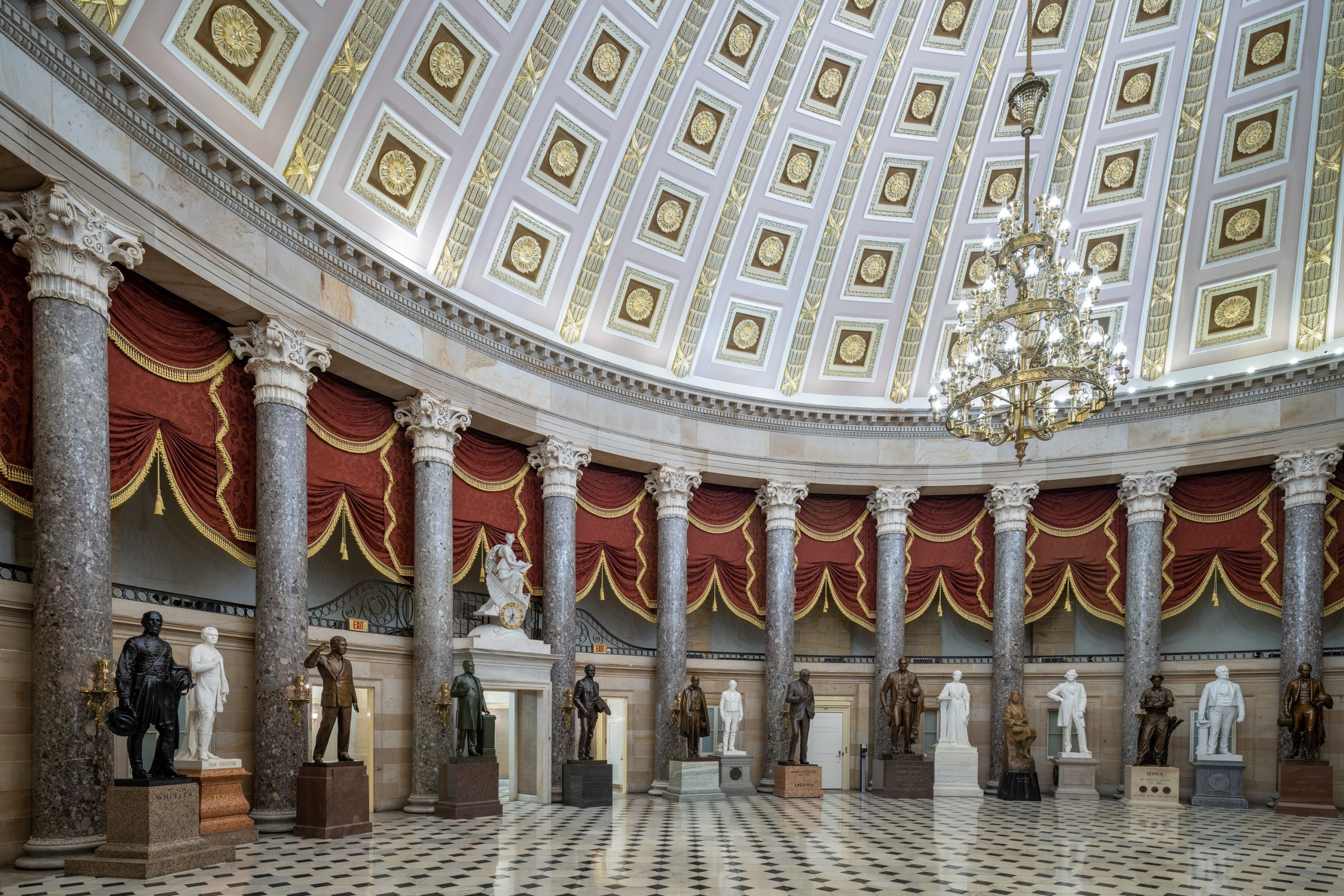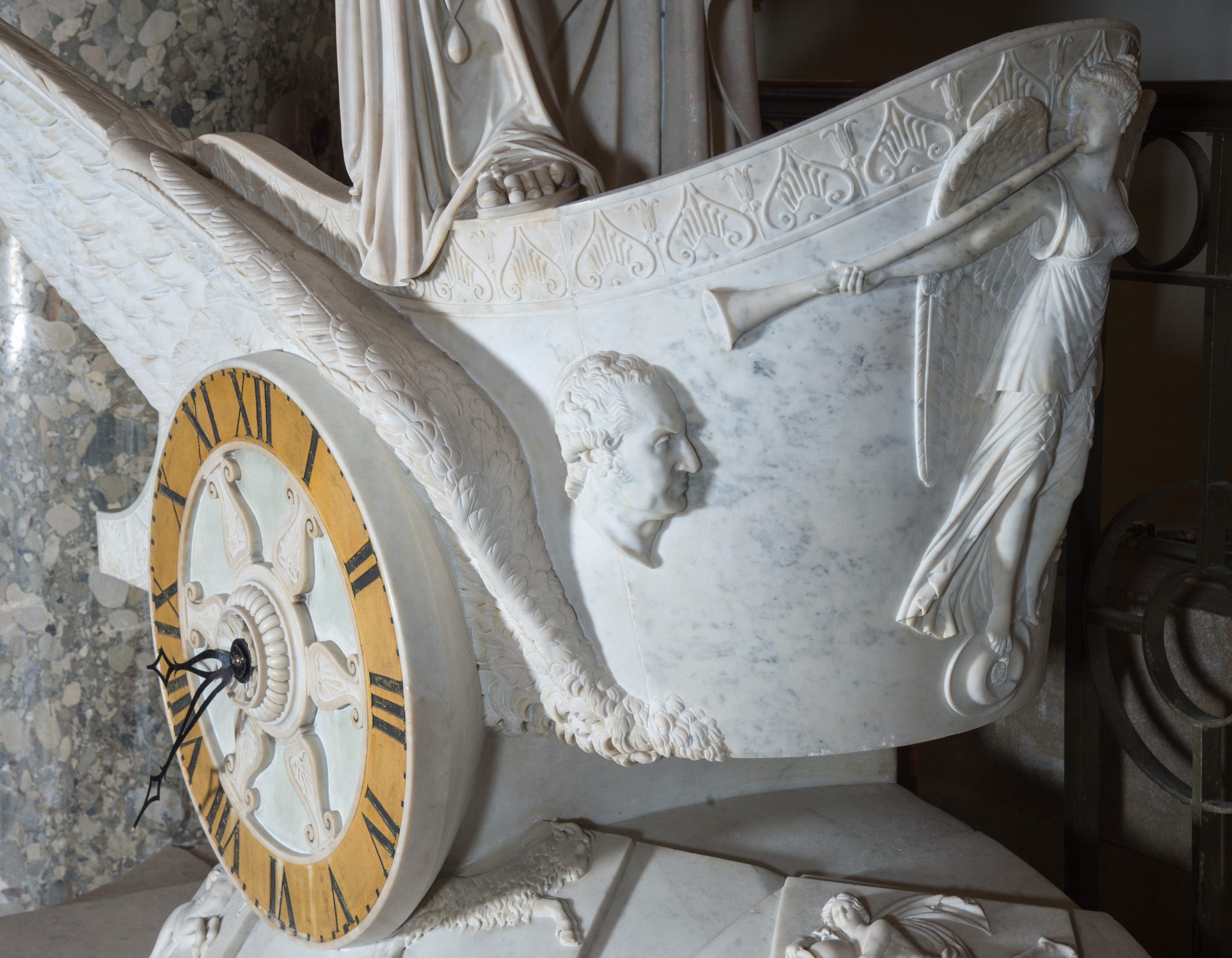Time Paused: Reflections on the Car of History
The breach of the Capitol on January 6, 2021, has not only reframed my view of this symbolic building’s relationship to the public, it has also prompted me to reengage with one of its oldest and most evocative works of art. The eloquent and functional Car of History (1819) by sculptor Carlo Franzoni (1789–1819) and clockmaker Simon Willard (1753–1848) transcends the circumstances of its commission and is as relevant today as it was two centuries ago.1 Situated above the entrance to the old Hall of the House of Representatives, now Statuary Hall, and opposite the original Speaker’s rostrum, it features Clio, the Greek Muse of History, recording events as time sweeps forward, literally and figuratively (fig. 1). It is a persistent reminder to legislators to be cognizant of their words and deeds and that they are accountable. For those of us who are not legislators but who visit or work in the Capitol, it is a sentinel and touchstone. One wonders what this silent witness observed on January 6 and how those events will ultimately be remembered.

The concept for the Car of History derives from a drawing that architect Benjamin Henry Latrobe (1764–1820) made in 1815, as he reenvisioned the Hall of the House of Representatives following its destruction by the British the previous year (fig. 2). In the original hippodrome-like chamber designed by Latrobe and completed in 1807, the architect had specified a celebratory sculptural allegorical figure of Liberty seated above the Speaker’s chair, capped by a rising eagle on the entablature, with four recumbent figures in high relief representing Agriculture, Art, Science, and Commerce carved into the opposite frieze. In designing the new Hall of the House of Representatives, Latrobe significantly altered the room shape, transforming it into a semicircular auditorium. He also rethought its sculptural program, creating two focal points facing one another, now that the space was shorter and wider. Above the north door, positioned between two Corinthian columns, he placed Clio in a Roman triumphal chariot. Across the chamber, a sculptural group faces her that is thematically similar to the one that had been destroyed by fire. Perhaps the recent devastation of the Capitol in the War of 1812 prompted Latrobe to see the work of Congress from a historical perspective.

In his sketch, Latrobe shows Clio seated with what appears to be a book in her lap, a pen in her right hand, and a mirror in her raised left hand, an attribute that is more commonly associated with figures of Prudence or Truth. A clock face with Roman numerals replaces the wheel of the double-winged chariot that moves from east to west. Latrobe may have been inspired by Second Empire mantel clocks, which also feature Roman-style chariots with clock face wheels and are often combined with mythological figures; however, Latrobe’s creative solution of literally wedding time with history on a monumental scale appears to be unprecedented.

Latrobe hired Italian sculptor Franzoni (the younger brother of Giuseppe, who had sculpted the high relief figures on the destroyed frieze), to execute his design. The architect clearly gave the sculptor artistic license to create the marble, as Franzoni’s neoclassical grouping is more sculptural and animated than the architect’s version (fig. 3). Gracefully poised in a sinuous S-curve, a standing Clio looks to her right as her body faces left, moving forward with the winged chariot that travels from west to east. Franzoni contrasts the articulated feathered wings of the chariot with the smooth surfaces of classically styled cascading drapery and Clio’s bare arm, poised in the act of writing in an open book (fig. 4). Evidence suggests that she previously held a quill pen. Her more natural posture, with her left foot resting on the edge of the car, diverges from the frontal, emblematic version Latrobe sketched. Franzoni also eliminated the raised mirror. Although based on classical mythology, the Car of History also includes details that particularize its time and placement, linking it to the nation’s founding and to Congress. A profile portrait of George Washington trumpeted by Nike, the goddess of victory, is carved in low relief near the front of the car (fig. 5). The clock face wheel of the car balances on a partial globe adorned with the zodiac signs Sagittarius, Aries, and Aquarius, referencing the months in which Congress typically convened. Time is represented here in not just minutes and hours, but also in days and seasons.


Clio in her winged chariot, the witness and guardian, the impartial listener, has been a muse for poets and scholars since antiquity. The Car of History figured in noted historian David McCullough’s acceptance speech for the United States Capitol Historical Society’s Freedom Award in 2016; it serves as the cover image for the periodical The Public Historian; and, perhaps most notably, its sculptural clock inspired John Quincy Adams, the sixth president, who later served eight terms in Congress, to write an antislavery poem. A poet as well as a statesman, Adams evoked the Car of History in “Fragments from an Unfinished Manuscript,” which appeared in 1846 in the Liberty Bell, an annual abolitionist gift book edited and published by Maria Weston Chapman. Adams introduced the poem as “An Epistle. To the Muse of History, perched on her Clock-wheeled Car over the door, fronting the Speaker’s Chair, in the Hall of the House of Representatives of the United States,” and began the poem with this stanza that beseeches Clio to descend from her ledge and participate in the debate on the House floor:
Muse, quit thy Car! Come down upon the floor,
And with thee bring that volume, in thy hand:
Tap with thy marble knuckles at the door,
And take at a reporter’s desk thy stand;
Send round thy album and collect a score
Of autographic Rulers of the land.
The Car of History has not lost its power to speak to contemporary audiences. It is an exemplar of public art that is both abstract and recognizable, a palimpsest that can be continually renewed. It is brilliantly sited in a space where unfolding events add the gauze of nuance. In contrast to history paintings that aggrandize and propagandize, Clio is above politics. She rides above the fray, or, as David McCullough remarked as he accepted the United States Capitol Historical Society’s Freedom Award on the chamber floor beneath her, “My feeling is Clio too is attending to her role no less than ever, taking note of the history we are and we will be making. On we go.”
Cite this article: Michele Cohen, “Time Paused: Reflections on the Car of History,” in Art and Politics in the US Capitol, special section, Panorama: Journal of the Association of Historians of American Art 7, no. 1 (Spring 2021), https://doi.org/10.24926/24716839.11784.
PDF: Cohen, Time Paused
Notes
The views presented are the author’s own, and do not represent the views of the Architect of the Capitol, the Congress, or the United States.
- For a recent detailed description of the Car of History, see Juan F. Déniz, “Bicentenary of the Car of History: A Monumental Chariot Clock in the US Capitol,” Antiquarian Horology 40, no. 2 (June 2019): 231–43. ↵
About the Author(s): Michele Cohen is Curator, Architect of the Capitol

